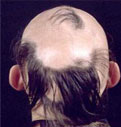 |
It is a
sudden
patchy hair
loss in
people with
no obvious
skin
disorder or
systemic
disease.
The scalp
and beard
are most
frequently
affected,
but any
hairy area
may be
involved.
Hair loss
may affect
most or all
of the body
(alopecia
universalis).
Alopecia
areata is
thought to
be an
autoimmune
disease
affecting
genetically
susceptible
people
exposed to
unclear
environment
triggers,
such as
infection or
emotional
stress. It
occasionally
coexists
with
autoimmune
vitiligo or
thyroditis.
|
|
| Nails are
sometimes pitched or
display
trachyonychia, a
roughness of nail is
also seen. |
|
Understanding
alopecia
areata:
The
hair is
made up
of a
protein
called
keratin
which is
also the
main
constituent
of
nails. A
specialised
structure
inside
the skin
called
‘Papilla'
produces
the hair
as shown
in the
figure.
The
papilla
is
surrounded
by a
sac-like
structure
called
the
‘Hair
follicle'
which
also
surrounds
rest of
the hair
root
within
the
skin.
The part
of the
hair
outside
the skin
surface
is
called
as shaft
|
|
Homoeopathic
Approach:
Alopecia being an
autoimmune disease
responds quite well
to homoeopathic
treatment. As in
such diseases deep
seated
constitutional
medications are
required as
administered in
homoeopathy.
It works by healing
the hair follicles
and reducing
inflammation so as
leading to permanent
cure.
These medicines do
not have any side
effects as for
corticosteroids used
by orthodox
treatment. Also the
cure that happens
subsequently through
these medicines does
not lead to hair
fall when the
administration is
stopped once the
patient is cured. |
Click
here for Case
Studies
|
|





